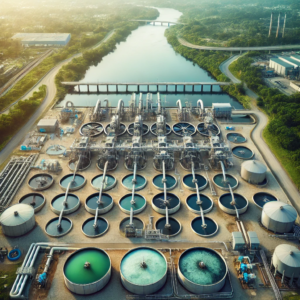 Chemical Pollutants, Which Pose Serious Environmental and Public Health Risks.
Chemical Pollutants, Which Pose Serious Environmental and Public Health Risks.
One of the most critical issues is ensuring the quality of treated water, especially when effluent is discharged into sensitive ecological areas or used as a source of drinking water.
The Aachen-Soers wastewater treatment plant, which serves 458,000 residents, illustrates these challenges. With a high daily flow rate, the plant’s treated water significantly impacts surrounding ecosystems. During dry weather, the plant’s effluent can make up as much as 80% of the flow in nearby water bodies that pass through protected and recreational areas before reaching international watercourses used for drinking water.
Microbiological contamination: Pathogenic organisms, including antibiotic-resistant strains, pose significant health risks.
Chemical pollutants: Contaminants from natural sources or industrial activities, such as bromide, can form harmful by-products like bromate during treatment.
Ecotoxicity: Untreated or poorly treated wastewater negatively affects aquatic ecosystems and biodiversity.
Ozone (O₃) is a powerful oxidant that effectively breaks down various pollutants in wastewater. Its application in wastewater treatment brings significant improvements in three critical areas:
Microbiological safety: Ozone treatment significantly reduces harmful bacteria such as E. coli and Enterococci, including antibiotic-resistant variants, by 1–3 log levels. This ensures that treated effluent poses minimal microbiological risks.
Chemical safety and bromate reduction: Bromate formation is a common issue in wastewater treatment, arising from ozone’s reaction with naturally occurring bromide. Advanced ozone treatment processes and optimized system designs successfully keep bromate levels below regulatory safety limits, ensuring chemical safety and compliance.
Reduction of ecotoxicity: By efficiently oxidizing a wide range of pollutants, ozone significantly lowers the ecotoxic impact of wastewater. This improves the ecological health of receiving water bodies, thereby supporting biodiversity and protecting sensitive environmental areas.
Modern ozone generation systems, such as those implemented in large-scale facilities, have demonstrated exceptional efficiency. For example, systems using ozone doses as low as 3.5 mg/L can remove over 80% of trace pollutants, significantly improving water quality. Additionally, ozone treatment systems generally have moderate operating costs, with total expenses ranging from €0.04 to €0.05 per m³ of treated wastewater.
Ozone technology is a highly effective solution for addressing critical wastewater treatment challenges. By significantly reducing microbiological and chemical contamination and minimizing ecological damage, ozone treatment ensures a safer and healthier environment, better ecosystem quality, and improved public health protection.